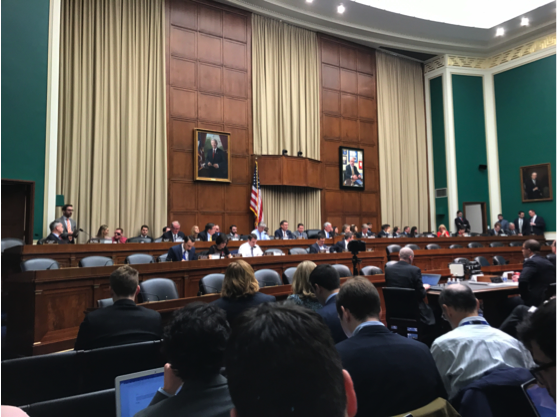February 17, 2017
For quite some time now, the auto industry and tech firms have discouraged Congress and the U.S. Department of Transportation from establishing federal policies on autonomous vehicles (AV).
However, with as many as 20 states now considering nearly 60 bills to regulate AV testing and deployment across the U.S., developers of the nascent technology are calling for the federal government to take action and develop uniform national standards for autonomous vehicles.
The issue at hand is the proverbial “patchwork of regulations” emerging as states draft disparate policies that could ultimately force AV manufacturers to jump through dozens of hoops before testing or deployment.
At a February 14 hearing before House Energy & Commerce’s newly-minted Digital Commerce and Consumer Protection Subcommittee, automakers and Lyft made an impassioned appeal to Congress:
Be our valentine.
 Recognizing the potential for inconsistent – and at worst, unbearable – results from 50 state entities (and the District of Columbia), the AV industry is turning to Congress and the National Highway Traffic Safety Administration (NHTSA) to be its one true regulator.
Recognizing the potential for inconsistent – and at worst, unbearable – results from 50 state entities (and the District of Columbia), the AV industry is turning to Congress and the National Highway Traffic Safety Administration (NHTSA) to be its one true regulator.
These things take time, of course. The rulemaking process is notoriously long – and any hopes of accelerating it are dashed by the sheer complexity of any proposed policy.
For most of its existence, NHTSA has primarily regulated the safety and performance of physical – not virtual – components of vehicles.
But setting prescriptive standards will not work for automated vehicle systems – an amalgamation of computers, software, and traditional parts, not to mention about a dozen sensors – that will likely use vastly different algorithms and components according to each manufacturers’ approach.
Instead, an emerging viewpoint is that the federal government should adopt an evidence-based approach to regulating AVs, whereby NHTSA would measure the ability of the automated system to operate safely and avoid collisions.
However, the way in which this would – or even could – be done is anyone’s guess.
Driving is an exceptionally complex task that extends beyond simply executing maneuvers that can be programmed into a computer. When humans drive, they must be constantly aware of the road around them and respond to a dynamic set of changing circumstances (weather, cyclists, and construction zones, to name a few).
GM, Volvo, and Toyota acknowledged that developing the new motor vehicle standards – and the measurements behind them – will take time, which is why they are urging Congress and NHTSA to work on them now.
Autonomous vehicle developers were heavily represented on the panel, with Nidhi Kalra of the RAND Corporation as the only non-industry voice:
- Mike Ableson, Vice President of Global Strategy, General Motors
- Anders Karrberg, Vice President of Government Affairs, Volvo Car Group
- Nidhi Kalra, Co-Director and Senior Information Scientist, RAND Center for Decision Making Under Uncertainty
- Gill Pratt, Executive Technical Advisor and CEO, Toyota Research Institute
- Joseph Okpaku, Vice President of Public Policy, Lyft
Falling in Love
It should not be a surprise that witnesses found sympathetic ears on the subcommittee. As ETW has written previously, autonomous vehicles have historically been a (somewhat) bipartisan topic where politicians are able to see what they want to see in the benefits of AVs.
This is why AVs are the Rorschach test of policy: Members start by seeing the issue in black and white, recognizing the safety and efficiency benefits of AVs versus human drivers. Then they begin to see both the political and personal benefits like bringing new investments to their district or enhancing the mobility of their family members with disabilities.
Subcommittee Chairman Bob Latta (R-OH), for example, lauded the potential of autonomous vehicles to save many of the 35,000 lives lost annually on America’s roadways – 1,000 of which were in his home state of Ohio in 2015.
But Latta also has a local interest in the development of AVs. Ohio Transportation Research Center (TRC), which lies just outside of his district, just TRC announced a $45 million investment in its AV testing facility, the Smart Mobility Advanced Research and Test Center in East Liberty, Ohio.
The vice chairman of the subcommittee, Rep. Gregg Harper (R-MS), had an especially personal interest. After his opening statement alluded to the potential for AVs to increase opportunities for people with disabilities, he later revealed that he had a son with intellectual disabilities.
“The possibilities are so good here,” he glowed, “What this opens up – whether it’s running errands, groceries, going to book store he loves…”
Abelson agreed, indicating that GM is currently working with engineers and external organizations to optimize AVs for use by people with disabilities.
And then there is Rep. Debbie Dingell (D-MI), who represents the district where the $80 million American Center for Mobility at Willow Run is now under construction. This 335-acre site will be used to test autonomous vehicles using existing infrastructure around its former World War II bomber factory and decommissioned General Motors plant, including a 2.5-mile highway loop that will be completed this December.

(Source: American Center for Mobility)
Meanwhile, Ranking Member Jan Schakowsky (D-IL) dedicated her questioning to the critical – yet entirely unrelated – issues of children dying after being left in hot cars.
Last year, Schakowsky introduced the HOT CARS Act of 2016 (H.R. 6041), which would have directed USDOT to issue a final rule within two years that requires vehicles to have a reminder system when drivers leave a child unattended in a vehicle.
Abelson, Pratt, and Karrberg indicated that their respective companies are incorporating this technology in future vehicle models.
The Industry Wish List
In a lightning round of yes/no questions from Dingell,
- Every panelist agreed that FMVSS needs to be updated;
- Every panelist agreed that NHTSA will be too slow in updating FMVSS and that AVs will probably be deployed before they are finalized;
- Most panelists agreed that expanding NHTSA exemption authority would yield positive results – Kalra and Pratt said it depends on the situation;
- Every panelist said that Congress should take an outcome-based approach rather than prescriptive.
Automakers and Lyft asked Congress to give NHTSA expanded FMVSS exemption authorities to allow large fleets of AVs to be deployed for ridesharing networks.
At present, AV manufacturers and tech firms would need to obtain exemptions from NHTSA in order to deploy vehicles that do not comply with existing vehicle standards (e.g., those without steering wheels or brake pedals).
This might be done either by raising the existing exemption caps, or creating a new type of exemption for AVs altogether:
- Substantial economic hardship: 10,000 cars
- Development or field evaluation of a new motor vehicle safety feature (most applicable right now): 2,500 cars
- Development or field evaluation of low-emission vehicles (might also be applicable for GM/Lyft with Chevy Bolt EV): 2,500 cars
- Safety level at least equal to nonexempt vehicles: 2,500 cars
Surprisingly, connected vehicle technology only came up once during the hearing. Typically vehicle-to-vehicle (V2V) and vehicle-to-infrastructure (V2I) technologies are lumped into conversations about autonomous vehicles as a way to realize increased safety and efficiency benefits.

(Source: Audi)
When asked by Rep. Gus Bilirakis (R-FL), Pratt indicated that connected vehicle technology – which may leverage V2I technologies like the smart stoplights Audi is testing in Las Vegas – will be “of critical importance to autonomous vehicles.”
No Free Rides Here
It seems that Rep. David McKinley (R-WV) was not sold on autonomous vehicles. After discussing his status as one of only two engineers in Congress and tout his expertise, he accosted Okpaku for suggesting that Lyft AVs could provide affordable and equitable transportation for low-income communities.
“So is the automobile, through the autonomous process, will that put us into entitlement program, or is this something that’s a privilege to be able to have a car? … I think maybe it was in your testimony that everyone should have this available to them.”
“Exactly,” replied Okpaku, proceeding to expand on how autonomous Lyfts would make on-demand transportation services affordable.
“That sounds like an entitlement,” the gentleman from West Virginia grumbled.

 Recognizing the potential for inconsistent – and at worst, unbearable – results from 50 state entities (and the District of Columbia), the AV industry is turning to Congress and the National Highway Traffic Safety Administration (NHTSA) to be its one true regulator.
Recognizing the potential for inconsistent – and at worst, unbearable – results from 50 state entities (and the District of Columbia), the AV industry is turning to Congress and the National Highway Traffic Safety Administration (NHTSA) to be its one true regulator.




